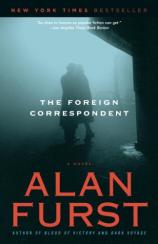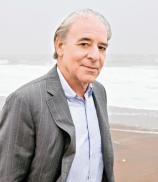The Foreign Correspondent
Review
The Foreign Correspondent
THE FOREIGN CORRESPONDENT takes place in Paris from the winter of
1938 through June 1939. Alan Furst's protagonist is Carlo Weisz, an
Italian expatriate who writes for Reuters, the international news
agency. Mussolini's fascist secret police, the OVRA, pursues him,
along with fellow emigres who have fled Italian government
suppression of individual freedom. These resistance fighters
utilize the weapons of ideas, essays and the typewriter instead of
firearms. The product of their idealism is Liberazione, a
clandestine emigre newspaper, distributed in Germany, France and
Italy.
The former editor of Liberazione has been murdered alongside
his lover in Paris, necessitating his replacement. Weisz is tapped
as editor by a select committee of intellectuals that decides the
content, distribution and fate of Liberazione. He's
reluctant at first but decides to speak out against Mussolini
through his penned words. He is immediately pursued by intelligence
operatives of the French and British governments to work toward
their cause of a free Europe in the face of impending war.
Germany's Hitler has pressed into the Balkans and is headed to
Italy, for either confrontation or collaboration with Mussolini.
Communists and anti-fascists in Europe dread the anticipated
results of the German imperialistic movements.
Furst moves his hero throughout Europe easily as a result of his
Reuters job, from London to Paris to Berlin, and eventually back to
Italy. In the meantime, Weisz finds himself the author of a
biography about an anti-fascist army officer, Colonel Ferrara, who
has fought for a lost case in Spain. Influential industrialists
sponsor the book, hoping that it will inspire others to fight
against Hitler's threat to their freedoms. SOLDIER FOR FREEDOM is
Weisz's finished product.
Weisz's personal life is complicated. Veronique, a gallery manager
in Paris who's his sexual partner and lover, becomes the object of
interrogation by the OVRA, posing as French police. Terrified, she
asks for details of Weisz's several occupations, wanting distance
between them. On a mission for Reuters in Berlin, he renews
acquaintance with a German aristocrat's wife, a former lover now
married. Christa inflames him with passion. However, she too has a
political agenda, against the German machine of Hitler.
Weisz must fulfill his most dangerous assignment for the
anti-fascists through Liberazione to secure Christa's safety
and removal from Berlin. Many clandestine operations taken on by
emigres from oppression are destined for failure. The OVRA is
active in European cities and is relentless in pursuit of
disenchanted citizens. Weisz's success or failure must be
ascertained in the book's final pages.
Furst begins THE FOREIGN CORRESPONDENT with a map of Paris in 1939.
Details showing meeting places for Liberazione's committee,
hotels and places of interest in the city are documented here. This
reader flipped back to the map for orientation during the course of
the experience. Furst describes social life in Paris and Berlin
during the pre-war days as normal but tense. When Weisz travels to
his native Italy for his final assignment, he discovers a changed
environment from the memories of his childhood. Furst has done his
research well in descriptions of people and places in the unsettled
pre-World War II time of the novel. THE FOREIGN CORRESPONDENT is
the right length to chronicle underground activities but could lead
to a sequel, with further revelations of anti-political
achievements leading to freedom.
Reviewed by Judy Gigstad on January 22, 2011
The Foreign Correspondent
- Publication Date: May 15, 2007
- Genres: Fiction, Historical Fiction
- Paperback: 288 pages
- Publisher: Random House Trade Paperbacks
- ISBN-10: 0812967976
- ISBN-13: 9780812967975





